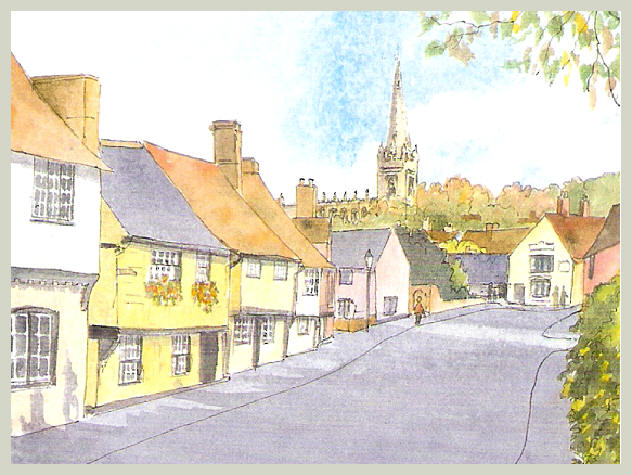HISTORY OF SAFFRON WALDEN

In memory of Margaret Hammond
Saffron Walden lies in the far corner of North West Essex on the banks of the Upper Cam Valley and archaeological evidence suggests that the area has been inhabited since at least Neolithic times.
Excavations during the 19th and 20th centuries unearthed much evidence of man's activity from then through the Bronze Age up to Roman times. Entries in the Domesday Book give us an insight into the Saxon manor and thereafter, from the Conquest, its subsequent disposal to William the Conqueror's chosen man, Geoffrey de Mandeville.
The market, originally moved from nearby Newport in 1141, and developing into a Tuesday and Saturday affair in 1295, continues to this day. Shortly after that, around 1300 the Town was granted its first charter, adding to its expanding prosperity, which within another 100 years or so took off with the wool trade adding to the area's wealth.
Despite the existence of wool related income continuing into the nineteenth century, it was soon overtaken by the saffron industry, providing the main source of revenue in the local area and also giving its name to the Town.
Whilst commercial cultivation of the plant is now extinct, having been overtaken by foreign imports by 1790, the Saffron crocus remains a symbol of Saffron Walden. Over the centuries, the Town was affected by the wider historic upheavals of England, such as in the reign of Henry VIII when, following the dissolution of the monasteries, Walden Abbey was handed over to one of the king's favourites, Thomas Audley. Religious turmoil ensued in the reigns of Mary and Elizabeth. During the Civil War Saffron Walden became for a while the headquarters of Oliver Cromwell. Later the appearance of religious non-conformity led to another period of great prosperity with the establishment of the Quaker movement. Furthermore it gained (and lost) its connection to the railway network and was even considered important enough by some entrepreneurs to have a proposal put before Parliament for its own canal link (which never came to fruition).
Saffron Walden went through tremendous change during Queen Victoria's reign with many new buildings of note being erected by wealthy residents who also, with a philanthropic eye, provided much to improve the way of educational, health and literary matters within the Town. Coincidentally the most notable of these benefactors were practising non-conformists, thus reflecting a long and well established religious tradition embedded in the Town and surrounding district since King Edward VI's reign.
Today Saffron Walden is an expanding municipality with an increasing population exceeding 15000 (consider during the Civil War, total souls numbered a mere 980!). It has its share of coffee shops and estate agents, but its centre is still classed as a conservation area and many of the buildings are considered unique, not only within Essex but in some cases in the United Kingdom.
